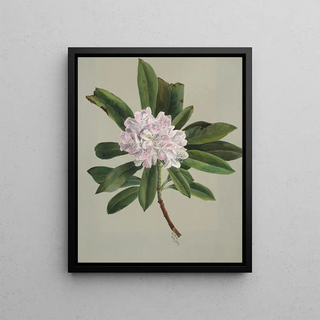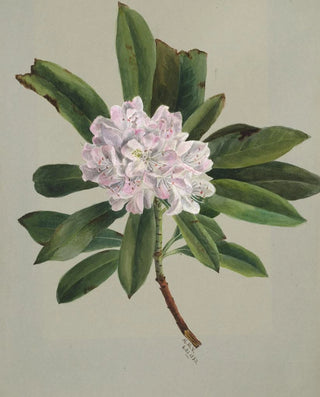Art print | Rhododendron Rhododendron maximum - Mary Vaux Walcott


View from behind

Frame (optional)
Mary Vaux Walcott's "Rhododendron Rhododendron maximum" is a true ode to nature, a celebration of floral beauty that awakens a sense of wonder in us. This delicate and meticulous depiction of a rhododendron not only showcases the artist's exceptional talent but also her passion for botany. Immersing oneself in this artwork transports the viewer to a universe where each petal seems to vibrate under the light, where shades of green and pink blend harmoniously to create a lively tableau. The art print of this piece allows for rediscovering the splendor of flora while paying tribute to an artist who captured the very essence of nature.
Style and uniqueness of the artwork
Mary Vaux Walcott's style is distinguished by her meticulous attention to detail and her ability to represent nature with an almost scientific precision. Every element of the composition is carefully studied, from the leaves to the flowers, including the subtleties of shadows and lights. This realistic approach, combined with artistic sensitivity, gives the work an almost tactile dimension, inviting the viewer to touch the beauty of rhododendrons. The color palette used in "Rhododendron Rhododendron maximum" is both soft and vibrant, creating a perfect balance between the delicacy of the flowers and the robustness of the foliage. Light plays a crucial role, adding depth and life to this depiction, transforming the piece into a true living tableau.
The artist and her influence
Mary Vaux Walcott, an emblematic figure of botanical art in the early 20th century, dedicated her life to studying and representing American plants. Her work is not limited to art but also aligns with a scientific approach, aiming to document the floral biodiversity of her time. As a member of the American Botanical Society, she contributed to raising public awareness about the beauty and fragility of ecosystems. Her influence endures today, both through her works and her commitment to conservation. The art prints of her works, such as

Matte finish

View from behind

Frame (optional)
Mary Vaux Walcott's "Rhododendron Rhododendron maximum" is a true ode to nature, a celebration of floral beauty that awakens a sense of wonder in us. This delicate and meticulous depiction of a rhododendron not only showcases the artist's exceptional talent but also her passion for botany. Immersing oneself in this artwork transports the viewer to a universe where each petal seems to vibrate under the light, where shades of green and pink blend harmoniously to create a lively tableau. The art print of this piece allows for rediscovering the splendor of flora while paying tribute to an artist who captured the very essence of nature.
Style and uniqueness of the artwork
Mary Vaux Walcott's style is distinguished by her meticulous attention to detail and her ability to represent nature with an almost scientific precision. Every element of the composition is carefully studied, from the leaves to the flowers, including the subtleties of shadows and lights. This realistic approach, combined with artistic sensitivity, gives the work an almost tactile dimension, inviting the viewer to touch the beauty of rhododendrons. The color palette used in "Rhododendron Rhododendron maximum" is both soft and vibrant, creating a perfect balance between the delicacy of the flowers and the robustness of the foliage. Light plays a crucial role, adding depth and life to this depiction, transforming the piece into a true living tableau.
The artist and her influence
Mary Vaux Walcott, an emblematic figure of botanical art in the early 20th century, dedicated her life to studying and representing American plants. Her work is not limited to art but also aligns with a scientific approach, aiming to document the floral biodiversity of her time. As a member of the American Botanical Society, she contributed to raising public awareness about the beauty and fragility of ecosystems. Her influence endures today, both through her works and her commitment to conservation. The art prints of her works, such as






